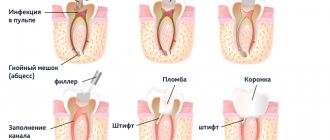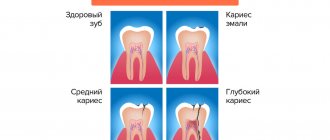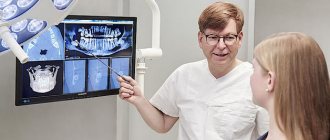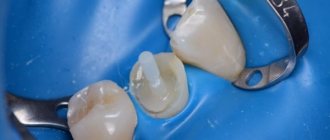Use of a microscope in dentistry: indications, advantages, features of dental treatment
Dental treatment is a very delicate job, because the tooth itself is small, and the root canals inside it are even smaller. Therefore, the clearer the doctor sees the picture, the more effectively he will carry out all the manipulations. To perform their work efficiently, modern specialists use equipment, for example, they perform dental treatment under a microscope. This procedure is gaining more and more popularity today, and we offer to learn about all its nuances, advantages, disadvantages and features. Details in the article!
Using optics in root canal treatment
Endodontic treatment is one of the most difficult.
This is due to limited visibility and the small size of the channel. The use of a microscope allows us to solve these problems and carry out all manipulations with high quality and with a guarantee. Some channels may have a negligibly small diameter and are completely invisible. All canals are visible under a microscope, so all canals will be sealed without exception.
Unfortunately, sometimes a fragment of the instrument breaks off, and part of it remains in the canal. Removing a foreign object is extremely difficult. The use of optics allows us to successfully solve this problem. The microscope is extremely useful when unfilling previously treated canals.
What is a dental microscope
A dental microscope is a high-precision optical device that can magnify an image of a tooth, as well as everything inside it, 20 times or more. This allows the endodontist or endodontist to carry out quite sophisticated work on cleaning canals, removing cysts or resection of the root apex. The dentist may also be able to see if there are abnormal or infected areas or may notice a foreign object inside the root canal.
Important! Many patients are afraid of using optical equipment in treatment because they think that the device will be placed in their mouth. However, this is not true. The device is located above the patient, at a distance of 20-30 cm from his face, which is convenient for both the patient and the doctor. The endodontist carries out therapy looking through the eyepieces, but the image from the device is also displayed on the monitor so that the assistant can observe the process and provide the doctor with the necessary tools.
Features of use in different clinical cases
No matter what area of dentistry magnifying optics is used, it always allows you to carry out the procedure with the highest quality and accuracy, working only with affected tissues and without affecting healthy ones. But in each individual case, the use of such technologies has its own characteristics and nuances.
As part of caries treatment
With an optical device, the dentist can better see the affected tissues and give an accurate assessment of the condition of the enamel, diagnosing caries at the very beginning of its development. In addition, with the help of such equipment, the doctor can carry out the procedure very carefully, without touching healthy areas. The microscope is also widely used for the restoration of minor damage, such as microcracks and chips.
For the treatment of pulpitis, depulpation and filling of canals
An advanced form of caries almost always leads to pulpitis. The infection penetrates deeper into the tissue and spreads to the neurovascular bundle - the pulp. In such a situation, the patient usually faces severe pain. In rare situations, it is possible to stop the pathological process using a therapeutic method, that is, by thoroughly cleansing the affected tissues and applying a special medicine to the nerve. The use of optics during this procedure significantly increases the chances of a favorable prognosis.
The microscope makes it possible to significantly improve the quality of tooth nerve removal
However, most often the diagnosis requires depulpation, that is, removal of the nerve with further treatment and filling of the root canals. As mentioned above, here a microscope makes it possible to significantly improve the quality of treatment, eliminate medical errors and, accordingly, reduce the risks of complications. Multiple magnification allows the doctor to accurately determine the location of the canal entry, detect and seal all the numerous branches, control the quality of antiseptic treatment and eliminate the risk of root perforation.
Dental restoration under magnification
Optical devices are also used in aesthetic dentistry and prosthetics, that is, as part of artistic restoration - here they allow high-quality preparation and preparation of enamel for subsequent composite build-up, installation of veneers and lumineers, restoration inlays and artificial crowns. This approach makes it possible to almost completely eliminate the insufficiently tight fit of the artificial material to living tissues and, in the future, the formation of gaps that create fertile conditions for the spread of infection and the development of caries.
Dental surgery with microscope
In surgery, optics are used to remove pathological tumors and resection of the root apex - cutting off its affected part along with a cyst or granuloma in the root region. Such equipment has made it possible to improve the quality and significantly increase the percentage of successful tooth-preserving operations, with minimal trauma to healthy tissue.
Areas of application of a dental microscope
A microscope is a highly accurate and rather expensive device, so its use in conventional caries treatment is unlikely to be justified. But those who believe that this optics are used only during complex surgical interventions will also be wrong.
In dentistry, such sensitive equipment has its own area of application:
- identifying the structure of channels, their number and branches,
- filling of tortuous canals,
- diagnosis of caries in the initial stage,
- detection of cracks in the enamel or canal wall,
- detection and removal of foreign objects (pieces of instruments, remains of filling materials, etc.) from root canals,
- diagnosis and treatment of canal or root perforation,
- assessment of the tightness of fit of restoration materials or prostheses (performed both during fitting and during their installation),
- tissue treatment before prosthetics to prevent damage to soft tissues or loss of healthy tooth structure,
- quality control of restoration or orthopedic work,
- removal of cysts, granulomas,
- some types of surgical work, including maxillofacial surgery.
Get a consultation
We will answer all your questions before visiting the clinic!
+7
Online registration
Aesthetic restoration of teeth under a microscope
The main objectives of restoration include: restoring proper contact between the teeth on both jaws, reproducing the anatomy of the tooth, and increasing its reliability in order to recreate functionality.
Errors can occur when the requirements for installing a filling are not met, and during treatment of the surface of a tooth that has previously been prepared. By using a microscope before and after cleaning, the specialist is able to exclude the presence of foreign materials and tissues, which has a positive effect on the prognosis of treatment.
In addition, the restoration must have a shade that matches the natural enamel and have a natural appearance. There is also a need to recreate transparency, which is quite achievable by treating caries under a microscope and increasing the working area.
Another important point when carrying out restoration work is the need to control the size of the joint. The use of a microscope also allows you to perform this task as accurately as possible and ensure proper contact of the edge of the filling with the tooth.
Possibilities of using a microscope in surgery
This optical device is particularly effective when performing surgical procedures. Its use guarantees minimally invasive surgical interventions, which is achieved through the use of small-sized instruments. In this case, both the operation itself and the rehabilitation period are greatly simplified.
Re-treatment of canals under a microscope
One of the leading areas in dentistry is the retreatment of root canals under a microscope, which is confirmed by numerous reviews. In turn, with the classic treatment option, burs are used, which often damage the canal walls and provoke the appearance of inflammatory processes in this area.
When treating tooth canals under a microscope, the following positive effects can be obtained:
- Branch detection;
- Effective dental treatment;
- Detecting cracks in the roots and lower part of the tooth cavity;
- Retrieving parts of previously used tools;
- High-quality canal filling;
- Possibility of removing affected areas and removing fillings.
Indications for using the microscope
There are no specific diseases in dentistry that cannot be treated without high-precision optics, but the quality of medical care greatly benefits from its use. This is especially true for complex cases, for example, dental treatment with any anomaly in the development of the jaw or with an atypical structure of the root canals (when they are highly branched or tortuous). The use of electronic optics when re-sealing canals is justified, because this requires first unsealing1 and cleaning the canals without damaging their walls. The doctor must make sure that no particles of the previous filling, medication, pin, etc. remain in their branches.
The use of a microscope in the treatment of cysts, granulomas and other neoplasms at the apex of the roots allows for high-precision resection or cystectomy without damaging the surrounding tissues, and most importantly, preserving the tooth. This is a very important point when removing a cyst or root tip, because improper operation or injury to adjacent tissues can lead to re-infection and growth of the cyst.
And of course, such a device is used in all organ-saving and minimally invasive (low-traumatic) endodontic operations.
What advantages can be identified
The advantages of using a microscope in various areas of dental practice are obvious. Among the main advantages, experts in the field of endodontics and their patients highlight the following points:
- a clear and detailed picture of what is happening in real time - for a specialist this is an opportunity to carry out diagnostics and the procedure itself as efficiently as possible, without missing a single branch in branched and confusing channels,
- less traumatic – the doctor uses small-diameter instruments and performs each manipulation with pinpoint precision, which can significantly reduce the risk of injury to healthy tissues,
- eliminating medical errors - when fragments of the instrument remain inside, the specialist does not completely fill the space with filling material or damages the root wall. In all these cases, secondary inflammation occurs, which can easily lead to the need for complete tooth extraction,
- the opportunity to save the situation even in the most dire case - magnifying optics allows for therapeutic treatment of extensive damage, poorly processed canals, large granulomas and cysts.
A detailed picture makes it possible to carry out diagnostics and the procedure itself as efficiently as possible.
Separately, we can highlight the comfort for both the dentist and the patient. The microscope allows you to increase the distance between them, which is sometimes very important for patients with dental phobia.
Progress of the procedure
Treatment using optical magnification is more comfortable for the patient. He reclines in a chair, which helps him relax better. In addition, the instruments that the doctor uses are much smaller than usual, and therefore do not cause discomfort or a gag reflex. This also allows the patient to swallow saliva normally. In addition, multiple magnification of the image allows the doctor to see the work area in great detail, and the patient does not need to open his mouth wide.
Where else is a microscope used?
Optics are used for inflammatory diseases of the oral cavity, such as pulpitis, periodontitis, as well as during various operations. Teeth have a rather complex anatomical structure and small sizes, so it is sometimes not possible to see all the details. Treatment under a microscope in Moscow allows you to reach a qualitatively new level.
The price of manipulations using optics is slightly higher than the cost of conventional treatment, but the result justifies the money spent. The amount of damage and discomfort will be minimal, and the service life of the treated teeth will increase. Some manipulations cannot be performed without magnification, so the device significantly expands the choice of techniques used and allows you to choose the optimal tactic for a particular patient.
Advantages of working with a microscope
Despite the fact that many dentists continue to treat teeth using conventional methods, many advanced clinics have already appreciated the quality of work using a microscope, because this method has a number of advantages:
- diagnostic accuracy: the use of high-precision optics allows you to diagnose caries at an early stage, when a drill is not required for its treatment. Multiple magnification allows you to examine hard-to-reach places (fissures, the junction of the crowns of adjacent teeth) and identify the beginning of pathological changes in the enamel,
- reduction of radiation exposure to the body: thanks to sensitive optics, the doctor can see with his own eyes the condition of the hard tissues of the tooth, its roots and canals, which means there is no need for radiography, which is especially valuable for pediatric dentistry,
- minimally invasive technologies: the endodontist can see the clinical picture in the smallest detail, which means that during his work he will not damage healthy tissue - gums, dentin, canal walls,
- high quality of work: when filling canals (especially if they have some anatomical features), it is very important to fill the entire cavity with filling material, leaving no voids or branches, so as not to create conditions for the development of microbes. In addition, the microscope allows you to verify the tightness of fillings or restoration overlays, to accurately fit the crown to the tooth,
- reduction of the rehabilitation period: often after canal filling, the patient experiences pain in the treated tooth for several days. This occurs due to the fact that nerve endings that have not been removed remain in the canal. The use of dental optics makes it possible to see and remove these particles, which relieves the patient of pain in the post-therapeutic period,
- monitoring the progress of work: since the high-resolution digital camera located inside the device displays the image on a large screen, the doctor can take a picture of any stage of work and any area of intervention. This allows him to adequately assess the quality of the work himself or invite colleagues to a consultation if a complex case requires consultation with another specialist - an orthopedist, surgeon, or orthodontist.
Why don't all clinics use a microscope?
Optics is expensive and technologically complex equipment. Many clinics are trying to save money by not purchasing a microscope. This approach does not guarantee the patient a high-quality service or a predicted result of the manipulations.
Result:
- there is a risk of repeated retreatment;
- medical errors;
- painful procedures due to damage to healthy tissue;
- It is impossible to save a tooth if there is no clear diagnosis and treatment plan.
The presence of optics in the clinic eliminates such possibilities. The difficulty is that to use the technique, the doctor must have a high level of qualifications, undergo expensive, lengthy training, and practice for a long time.
Axioma Dental is a modern dentistry clinic where, using a powerful microscope, effective treatment of pathologies is carried out with a guaranteed predictable result.
Sources:
- L. I. Nikitina, L. R. Mukhamedzhanova, I. A. Khanova, E. M. Speranskaya; Federal State Budgetary Educational Institution of Higher Education “Chuvash State University named after I. N. Ulyanov. Operating microscope in dentistry, 2017
- Speranskaya E. M. Operating microscope in dentistry, educational and methodological manual for students of II-Vl years of the Faculty of Dentistry, interns, residents, dentists, 2017
- Veshcheva Yu.G. Expert analysis of errors and complications of endodontic treatment (medical and legal aspects), 2005
Expert author:
Koussevitzky Leonid Yakovlevich
Orthopedic dentist, Dr. med. sciences
The information presented in this article is provided for reference purposes and does not replace the advice of a qualified specialist.
At the first signs of illness, you should consult a doctor.
Tell us about us:
Complications after working under a microscope
As a rule, there are no complications after therapy where a detailed microscope was used. The risk is minimized, since the doctor has the opportunity to see the area of work in detail and control the process at all its stages. All complications arise when working without a microscope, because the doctor does not see the nuances, can injure neighboring tissues, accidentally pierce the walls of the canal, break the tip of the instrument in the root branch and not even notice it.
Attention! If after treatment with the use of optics a complication does occur, then this indicates a low qualification of the endodontist or a malfunction of the equipment.
Microscope - luxury or necessity?
Harry Kahr, who was the first to use a microscope in dental treatment, briefly and clearly substantiated the principle of its necessity: “You can only treat what you can see.” With traditional treatment, the doctor’s “view” is limited to what is reflected in the dental mirror, while the microscope intended for dental treatment has a thirty-fold magnification, making the examination of the surface of the tooth and its internal structure more detailed and complete. This not only allows the doctor, who normally works almost by touch, to better see the area being treated, but also reduces the amount of living tissue removed during drilling, and also reduces to zero the risk of “looking through” a carious cavity or an uncleaned canal.










